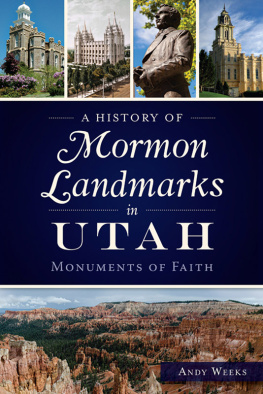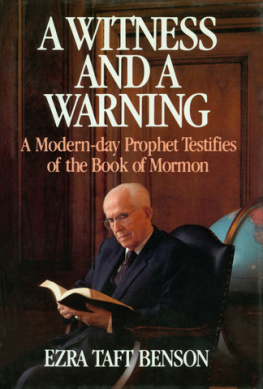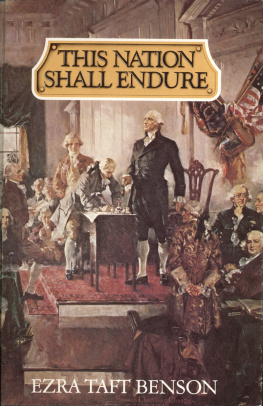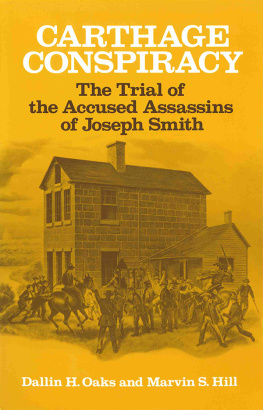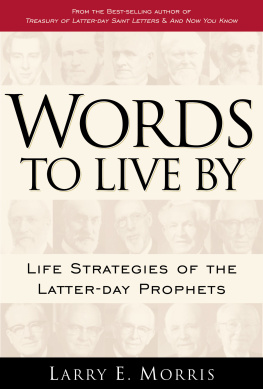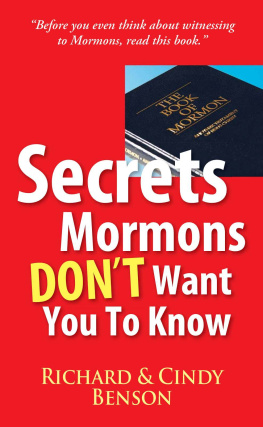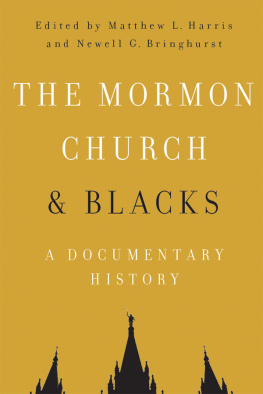NOTES
ACKNOWLEDGMENTS
Ezra Taft Benson, Dwight D. Eisenhower and the Emergence of a Mormon Conspiracy within the Mormon Church, John Whitmer Historical Association Journal 37, no. 1 (SpringSummer 2017): 5182; and The Last State to Honor MLK: Utah and the Quest for Racial Justice, 19852000, Utah Historical Quarterly (forthcoming Winter 2020).
INTRODUCTION
. Arguably, the only other LDS apostle to rival Bensons political proclivities is Reed Smoot, who served in the U.S. Senate from 1903 to 1933, coinciding with his tenure in the Quorum of the Twelve Apostles. The definitive work on Smoot is Kathleen Flake, The Politics of American Religious Identity: The Seating of Senator Reed Smoot, Mormon Apostle (Chapel Hill: University of North Carolina Press, 2003), but also useful are Milton R. Merrill, Reed Smoot: Apostle in Politics (Logan: Utah State University Press, 1990), and Konden R. Smith, The Reed Smoot Hearings and the Theology of Politics: Perceiving an American Identity, Journal of Mormon History 35, no. 3, (Summer 2009): 11862. The other high-ranking government official was J. Reuben Clark, who served in several government positions before he was called as an apostle. For Clarks background in government, see D. Michael Quinn, Elder Statesman: A Biography of J. Reuben Clark (Salt Lake City: Signature Books, 2002).
. Presidential Citizens Medal Commemoration for Ezra Taft Benson, reel 1, Ezra Taft Benson Papers, LDS Church History Library (courtesy of Jay Burrup). See also President Benson Awarded Presidential Citizens Medal, Deseret News , July 29, 1989.
. The First Presidency is comprised of the church president and his two counselors.
Ezra Taft Benson, oral history interview with James B. Allen, May 16, 1975, 90, LDS Church History Library.
. See Harris, Breaching the Wall: Ezra Taft Benson on Church and State, in Matthew L. Harris, ed., Thunder from the Right: Ezra Taft Benson in Mormonism and Politics (Urbana: University of Illinois Press, 2019), 118.
A Witness and a Warning: A Modern-day Prophet Testifies of the Book of Mormon (Salt Lake City: Deseret Book, 1988). See also Sheri L. Dew, Ezra Taft Benson: A Biography (Salt Lake City: Deseret Book, 1987), chap. 19 (Sounding a Warning). The watchman on the tower metaphor derives from several places in Mormon scripture: Bible (2 Kings 9:17; Isaiah 62:7; Ezekiel 3:17), Book of Mormon (3 Nephi 16:1718), Doctrine and Covenants (sec. 101:4445).
. For four insightful expressions of American exceptionalism, see Andrew Burstein, Sentimental Democracy: The Evolution of Americas Romantic Self-Image (New York: Hill and Wang, 1999); Thomas Bender, A Nation among Nations: Americas Place in World History (New York: Hill and Wang, 2006); Andrew Preston, Sword of the Shield of Faith: Religion in American War and Diplomacy (New York: Alfred A. Knopf, 2012); and Daniel T. Rodgers, As a City on a Hill: The Story of Americas Most Famous Lay Sermon (Princeton, NJ: Princeton University Press, 2018).
. Benson to Reagan, May 29, 1984, Box 7, Latter-day Saints (Mormons) file, Ronald Reagan Presidential Library, Simi Valley, CA.
.
. Benson to Our Beloved Children, August 10, 1981, quoted in Dew, Ezra Taft Benson , 476.
. Benson, So Shall Ye Reap: Selected Addresses of Ezra Taft Benson , comp. Reed A. Benson (Salt Lake City: Deseret Book, 1960), 39; and David O. McKay, journal, October 26, 1962, Box 51, Folder 5, David O. McKay Papers, Special Collections, J. Willard Marriott Library, University of Utah. See D. Michael Quinn, The Mormon Hierarchy: Extensions of Power (Salt Lake City: Signature Books, 1997), 68, 111; Cleon Skousen, Behind the Scenes, Freemen Institute Newsletter , 1979, Box 1, Folder 3, Freemen Institute Records, 19631980, Special Collections, J. Willard Marriott Library, University of Utah (Mark Bensons appointment as the vice president of the Freemen Institute).
. Quinn, The Mormon Hierarchy , 68; Allen, oral history, 119; Steve Benson, Ezra Taft Benson: A Grandsons Remembrance, Sunstone (December 1994): 3032. Steve Mayfield, a missionary in the Denver, Colorado, mission (19711973), reports that, after having dinner with Beverly Benson Parker, Ezras daughter, she encouraged him and his companion to join the Birch Society after their mission. In email to author, February 25, 2019.
. Allen, oral history, 107, 111.
Dwight D. Eisenhower, Mandate for Change: The White House Years (New York: Doubleday, 1963), 354. Lowry Nelson, who taught Benson in three sociology courses, stated: Ezra annoys me very much; he takes himself so damn seriously. Nelson to BYU religion professor Gustive O. Larson, February 3, 1976, Box 11, Folder 16, Gustive O. Larson Papers, L. Tom Perry Special Collections, Harold B. Lee Library, Brigham Young University, Provo, UT.
Statements of the LDS First Presidency , compiled by Gary James Bergera (Salt Lake City: Signature Books, 2007), 4144.
Boyd K. Packer, The Mantle Is Far, Far Greater than the Intellect, BYU Studies 21 (1981): 25977.
. Leonard J. Arrington, Adventures of a Church Historian (Urbana: University of Illinois Press, 1998), esp. chap. 9; Gregory A. Prince, Leonard J. Arrington and the Writing of Mormon History (Salt Lake City: University of Utah Press, 2016), chap. 20. General authorities, including Benson, had long been suspicious of liberal Mormon journals like Dialogue and Sunstone and counseled BYU faculty not to publish their work in them or speak at their symposia. For this point, see Lavina Fielding Anderson, The LDS Intellectual Community and Church Leadership: A Contemporary Chronology, Dialogue: A Journal of Mormon Thought 26 (Spring 1993): 28; Claudia L. Bushman, Contemporary Mormonism: Latter-day Saints in Modern America (New York: Rowman and Littlefield, 2006), 15758; Terryl L. Givens, People of Paradox: A History of Mormon Culture (New York: Oxford University Press, 2007), 22526.
. Benson to Clark Mollenhoff, October 6, 1969, Box 10, Folder 1, Clark R. Mollenhoff Papers, Wisconsin Historical Society, Madison, WI. See, for example, Benson to John Foster Dulles (February 16, 1959): You have been very much in our thoughts and prayers the last few days. It is my fervent hope and prayer that a kind Providence will see fit to restore you fully to health and strength. In Box 138, Reel 54, John Foster Dulles Papers, Department of Rare Books and Special Collections, Firestone Library, Princeton University. The Benson papers at the Eisenhower Presidential Library, LDS Church History Library, and countless other archives where I have researched, include dozens of sympathy expressions, birthday and holiday greetings, and congratulations sentiments from the apostle.
John Foster Dulles Papers.
. Benson, quoted in Benson Says Black Is Red, Daily Utah Chronicle , October 7, 1963.
. Benson, The Red Carpet: SocialismThe Royal Road to Communism (Salt Lake City: Bookcraft, 1962).
. See chapters 35 of ibid.
Robert Robins and Jerold Post, Political Paranoia: The Psychopolitics of Hatred (New Haven, CT: Yale University Press, 1997), 57.
.
Randall Balmer, Evangelicalism in America (Waco, TX: Baylor University Press, 2016). In the twentieth century, the most prominent Mormon discourses on the End Times included Joseph Fielding Smith, The Signs of the Times: A Series of Discussions (Salt Lake City: Deseret News Press, 1942), and Bruce R. McConkie, Mormon Doctrine (Salt Lake City: Bookcraft, 1958), esp. 64563.
Grant Underwood, The Millenarian World of Early Mormonism (Urbana: University of Illinois Press, 1993), esp. 2529, 7475.
. Robert Goldberg, Enemies Within: The Culture of Conspiracy in Modern America (New Haven, CT: Yale University Press, 2001), xii.




